dimensions FIAT 500X 2017 Owner handbook (in English)
[x] Cancel search | Manufacturer: FIAT, Model Year: 2017, Model line: 500X, Model: FIAT 500X 2017Pages: 284, PDF Size: 11.14 MB
Page 44 of 284
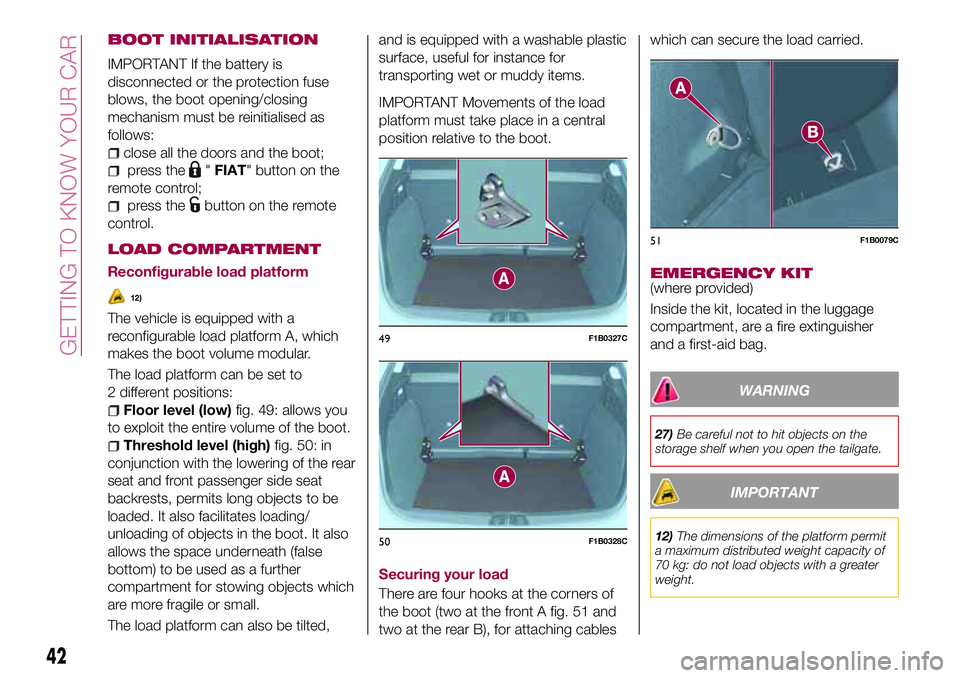
BOOT INITIALISATION
IMPORTANT If the battery is
disconnected or the protection fuse
blows, the boot opening/closing
mechanism must be reinitialised as
follows:
close all the doors and the boot;
press the"FIAT" button on the
remote control;
press thebutton on the remote
control.
LOAD COMPARTMENT
Reconfigurable load platform
12)
The vehicle is equipped with a
reconfigurable load platform A, which
makes the boot volume modular.
The load platform can be set to
2 different positions:
Floor level (low)fig. 49: allows you
to exploit the entire volume of the boot.
Threshold level (high)fig. 50: in
conjunction with the lowering of the rear
seat and front passenger side seat
backrests, permits long objects to be
loaded. It also facilitates loading/
unloading of objects in the boot. It also
allows the space underneath (false
bottom) to be used as a further
compartment for stowing objects which
are more fragile or small.
The load platform can also be tilted,and is equipped with a washable plastic
surface, useful for instance for
transporting wet or muddy items.
IMPORTANT Movements of the load
platform must take place in a central
position relative to the boot.
Securing your load
There are four hooks at the corners of
the boot (two at the front A fig. 51 and
two at the rear B), for attaching cableswhich can secure the load carried.
EMERGENCY KIT(where provided)
Inside the kit, located in the luggage
compartment, are a fire extinguisher
and a first-aid bag.
WARNING
27)Be careful not to hit objects on the
storage shelf when you open the tailgate.
IMPORTANT
12)The dimensions of the platform permit
a maximum distributed weight capacity of
70 kg: do not load objects with a greater
weight.
49F1B0327C
50F1B0328C
51F1B0079C
42
GETTING TO KNOW YOUR CAR
Page 75 of 284
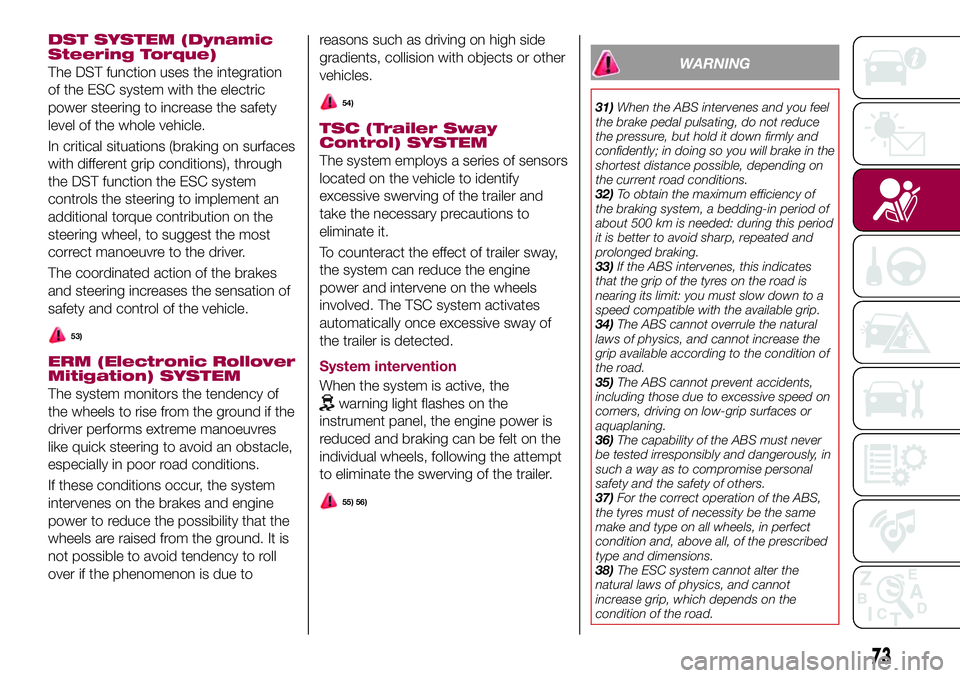
DST SYSTEM (Dynamic
Steering Torque)
The DST function uses the integration
of the ESC system with the electric
power steering to increase the safety
level of the whole vehicle.
In critical situations (braking on surfaces
with different grip conditions), through
the DST function the ESC system
controls the steering to implement an
additional torque contribution on the
steering wheel, to suggest the most
correct manoeuvre to the driver.
The coordinated action of the brakes
and steering increases the sensation of
safety and control of the vehicle.
53)
ERM (Electronic Rollover
Mitigation) SYSTEM
The system monitors the tendency of
the wheels to rise from the ground if the
driver performs extreme manoeuvres
like quick steering to avoid an obstacle,
especially in poor road conditions.
If these conditions occur, the system
intervenes on the brakes and engine
power to reduce the possibility that the
wheels are raised from the ground. It is
not possible to avoid tendency to roll
over if the phenomenon is due toreasons such as driving on high side
gradients, collision with objects or other
vehicles.
54)
TSC (Trailer Sway
Control) SYSTEM
The system employs a series of sensors
located on the vehicle to identify
excessive swerving of the trailer and
take the necessary precautions to
eliminate it.
To counteract the effect of trailer sway,
the system can reduce the engine
power and intervene on the wheels
involved. The TSC system activates
automatically once excessive sway of
the trailer is detected.
System intervention
When the system is active, the
warning light flashes on the
instrument panel, the engine power is
reduced and braking can be felt on the
individual wheels, following the attempt
to eliminate the swerving of the trailer.
55) 56)
WARNING
31)When the ABS intervenes and you feel
the brake pedal pulsating, do not reduce
the pressure, but hold it down firmly and
confidently; in doing so you will brake in the
shortest distance possible, depending on
the current road conditions.
32)To obtain the maximum efficiency of
the braking system, a bedding-in period of
about 500 km is needed: during this period
it is better to avoid sharp, repeated and
prolonged braking.
33)If the ABS intervenes, this indicates
that the grip of the tyres on the road is
nearing its limit: you must slow down to a
speed compatible with the available grip.
34)The ABS cannot overrule the natural
laws of physics, and cannot increase the
grip available according to the condition of
the road.
35)The ABS cannot prevent accidents,
including those due to excessive speed on
corners, driving on low-grip surfaces or
aquaplaning.
36)The capability of the ABS must never
be tested irresponsibly and dangerously, in
such a way as to compromise personal
safety and the safety of others.
37)For the correct operation of the ABS,
the tyres must of necessity be the same
make and type on all wheels, in perfect
condition and, above all, of the prescribed
type and dimensions.
38)The ESC system cannot alter the
natural laws of physics, and cannot
increase grip, which depends on the
condition of the road.
73
Page 76 of 284
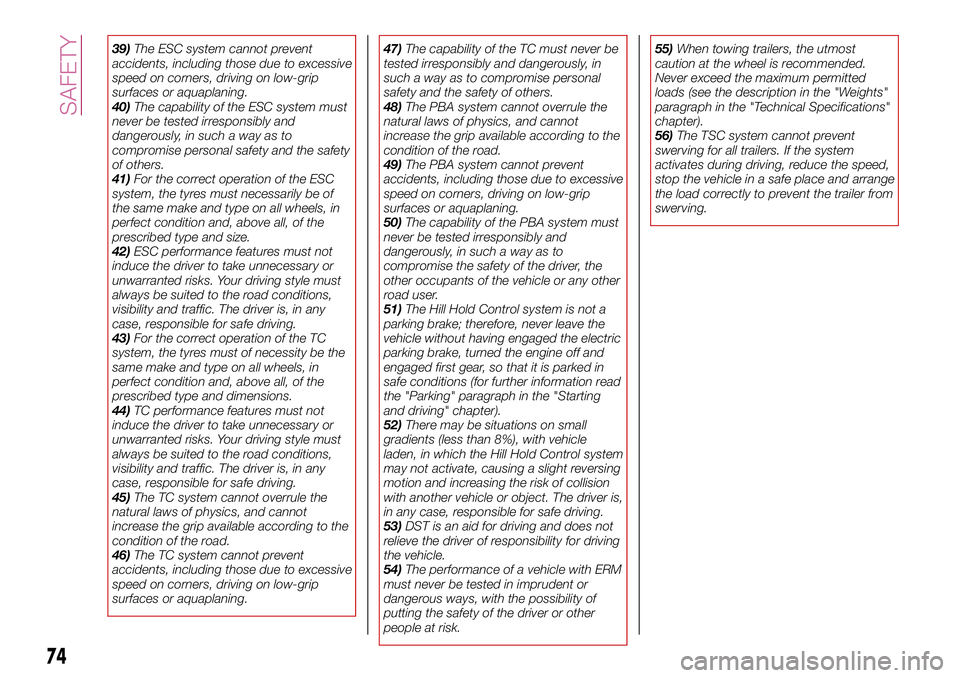
39)The ESC system cannot prevent
accidents, including those due to excessive
speed on corners, driving on low-grip
surfaces or aquaplaning.
40)The capability of the ESC system must
never be tested irresponsibly and
dangerously, in such a way as to
compromise personal safety and the safety
of others.
41)For the correct operation of the ESC
system, the tyres must necessarily be of
the same make and type on all wheels, in
perfect condition and, above all, of the
prescribed type and size.
42)ESC performance features must not
induce the driver to take unnecessary or
unwarranted risks. Your driving style must
always be suited to the road conditions,
visibility and traffic. The driver is, in any
case, responsible for safe driving.
43)For the correct operation of the TC
system, the tyres must of necessity be the
same make and type on all wheels, in
perfect condition and, above all, of the
prescribed type and dimensions.
44)TC performance features must not
induce the driver to take unnecessary or
unwarranted risks. Your driving style must
always be suited to the road conditions,
visibility and traffic. The driver is, in any
case, responsible for safe driving.
45)The TC system cannot overrule the
natural laws of physics, and cannot
increase the grip available according to the
condition of the road.
46)The TC system cannot prevent
accidents, including those due to excessive
speed on corners, driving on low-grip
surfaces or aquaplaning.47)The capability of the TC must never be
tested irresponsibly and dangerously, in
such a way as to compromise personal
safety and the safety of others.
48)The PBA system cannot overrule the
natural laws of physics, and cannot
increase the grip available according to the
condition of the road.
49)The PBA system cannot prevent
accidents, including those due to excessive
speed on corners, driving on low-grip
surfaces or aquaplaning.
50)The capability of the PBA system must
never be tested irresponsibly and
dangerously, in such a way as to
compromise the safety of the driver, the
other occupants of the vehicle or any other
road user.
51)The Hill Hold Control system is not a
parking brake; therefore, never leave the
vehicle without having engaged the electric
parking brake, turned the engine off and
engaged first gear, so that it is parked in
safe conditions (for further information read
the "Parking" paragraph in the "Starting
and driving" chapter).
52)There may be situations on small
gradients (less than 8%), with vehicle
laden, in which the Hill Hold Control system
may not activate, causing a slight reversing
motion and increasing the risk of collision
with another vehicle or object. The driver is,
in any case, responsible for safe driving.
53)DST is an aid for driving and does not
relieve the driver of responsibility for driving
the vehicle.
54)The performance of a vehicle with ERM
must never be tested in imprudent or
dangerous ways, with the possibility of
putting the safety of the driver or other
people at risk.55)When towing trailers, the utmost
caution at the wheel is recommended.
Never exceed the maximum permitted
loads (see the description in the "Weights"
paragraph in the "Technical Specifications"
chapter).
56)The TSC system cannot prevent
swerving for all trailers. If the system
activates during driving, reduce the speed,
stop the vehicle in a safe place and arrange
the load correctly to prevent the trailer from
swerving.
74
SAFETY
Page 82 of 284
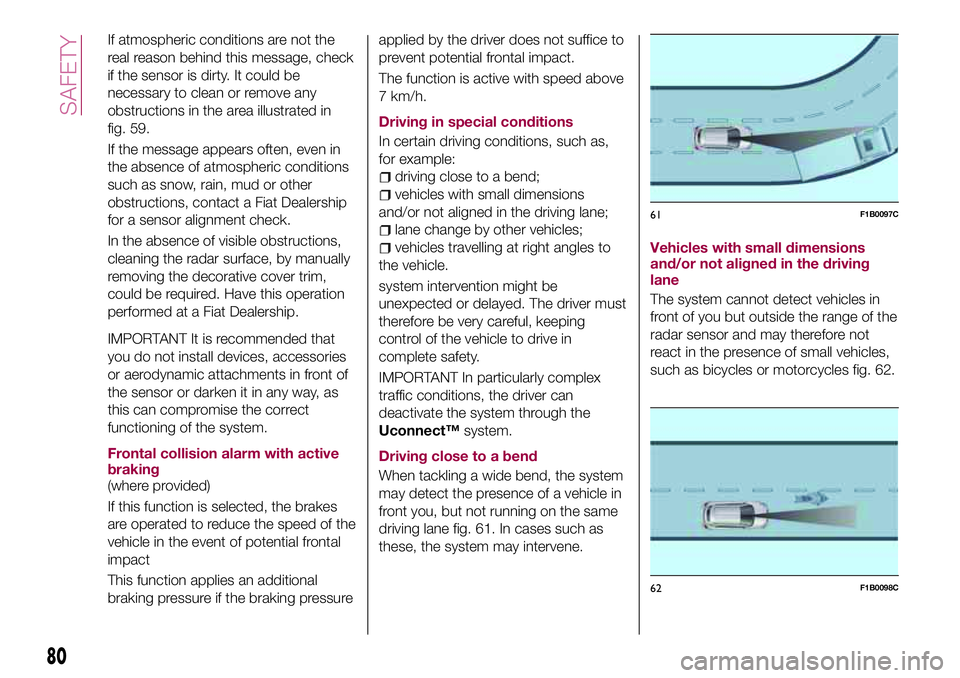
If atmospheric conditions are not the
real reason behind this message, check
if the sensor is dirty. It could be
necessary to clean or remove any
obstructions in the area illustrated in
fig. 59.
If the message appears often, even in
the absence of atmospheric conditions
such as snow, rain, mud or other
obstructions, contact a Fiat Dealership
for a sensor alignment check.
In the absence of visible obstructions,
cleaning the radar surface, by manually
removing the decorative cover trim,
could be required. Have this operation
performed at a Fiat Dealership.
IMPORTANT It is recommended that
you do not install devices, accessories
or aerodynamic attachments in front of
the sensor or darken it in any way, as
this can compromise the correct
functioning of the system.
Frontal collision alarm with active
braking
(where provided)
If this function is selected, the brakes
are operated to reduce the speed of the
vehicle in the event of potential frontal
impact
This function applies an additional
braking pressure if the braking pressureapplied by the driver does not suffice to
prevent potential frontal impact.
The function is active with speed above
7 km/h.
Driving in special conditions
In certain driving conditions, such as,
for example:
driving close to a bend;
vehicles with small dimensions
and/or not aligned in the driving lane;
lane change by other vehicles;
vehicles travelling at right angles to
the vehicle.
system intervention might be
unexpected or delayed. The driver must
therefore be very careful, keeping
control of the vehicle to drive in
complete safety.
IMPORTANT In particularly complex
traffic conditions, the driver can
deactivate the system through the
Uconnect™system.
Driving close to a bend
When tackling a wide bend, the system
may detect the presence of a vehicle in
front you, but not running on the same
driving lane fig. 61. In cases such as
these, the system may intervene.Vehicles with small dimensions
and/or not aligned in the driving
lane
The system cannot detect vehicles in
front of you but outside the range of the
radar sensor and may therefore not
react in the presence of small vehicles,
such as bicycles or motorcycles fig. 62.
61F1B0097C
62F1B0098C
80
SAFETY
Page 197 of 284
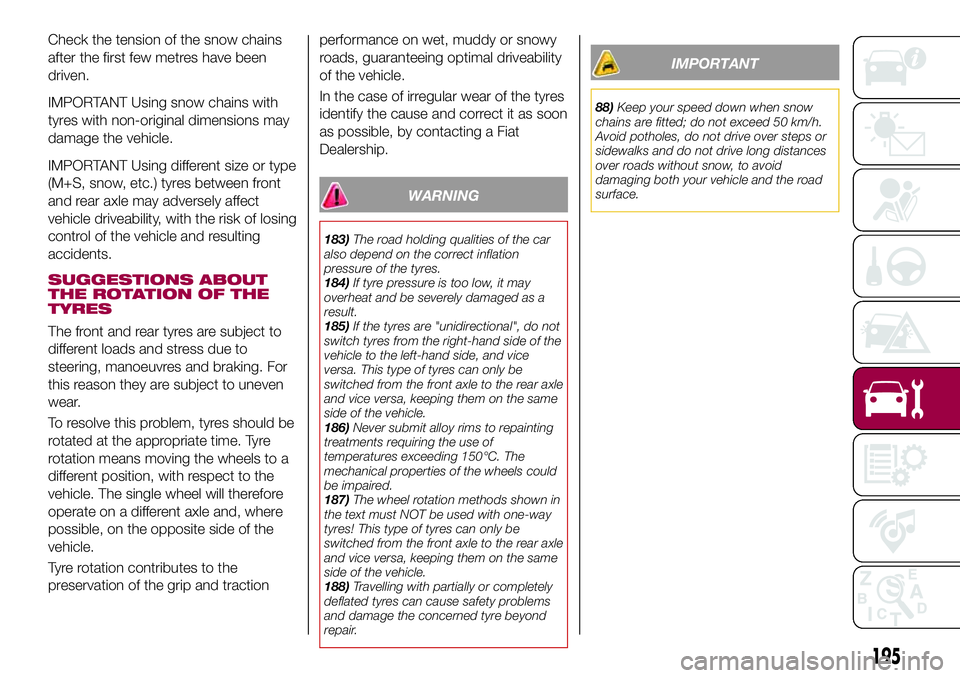
Check the tension of the snow chains
after the first few metres have been
driven.
IMPORTANT Using snow chains with
tyres with non-original dimensions may
damage the vehicle.
IMPORTANT Using different size or type
(M+S, snow, etc.) tyres between front
and rear axle may adversely affect
vehicle driveability, with the risk of losing
control of the vehicle and resulting
accidents.
SUGGESTIONS ABOUT
THE ROTATION OF THE
TYRES
The front and rear tyres are subject to
different loads and stress due to
steering, manoeuvres and braking. For
this reason they are subject to uneven
wear.
To resolve this problem, tyres should be
rotated at the appropriate time. Tyre
rotation means moving the wheels to a
different position, with respect to the
vehicle. The single wheel will therefore
operate on a different axle and, where
possible, on the opposite side of the
vehicle.
Tyre rotation contributes to the
preservation of the grip and tractionperformance on wet, muddy or snowy
roads, guaranteeing optimal driveability
of the vehicle.
In the case of irregular wear of the tyres
identify the cause and correct it as soon
as possible, by contacting a Fiat
Dealership.
WARNING
183)The road holding qualities of the car
also depend on the correct inflation
pressure of the tyres.
184)If tyre pressure is too low, it may
overheat and be severely damaged as a
result.
185)If the tyres are "unidirectional", do not
switch tyres from the right-hand side of the
vehicle to the left-hand side, and vice
versa. This type of tyres can only be
switched from the front axle to the rear axle
and vice versa, keeping them on the same
side of the vehicle.
186)Never submit alloy rims to repainting
treatments requiring the use of
temperatures exceeding 150°C. The
mechanical properties of the wheels could
be impaired.
187)The wheel rotation methods shown in
the text must NOT be used with one-way
tyres! This type of tyres can only be
switched from the front axle to the rear axle
and vice versa, keeping them on the same
side of the vehicle.
188)Travelling with partially or completely
deflated tyres can cause safety problems
and damage the concerned tyre beyond
repair.
IMPORTANT
88)Keep your speed down when snow
chains are fitted; do not exceed 50 km/h.
Avoid potholes, do not drive over steps or
sidewalks and do not drive long distances
over roads without snow, to avoid
damaging both your vehicle and the road
surface.
195
Page 201 of 284
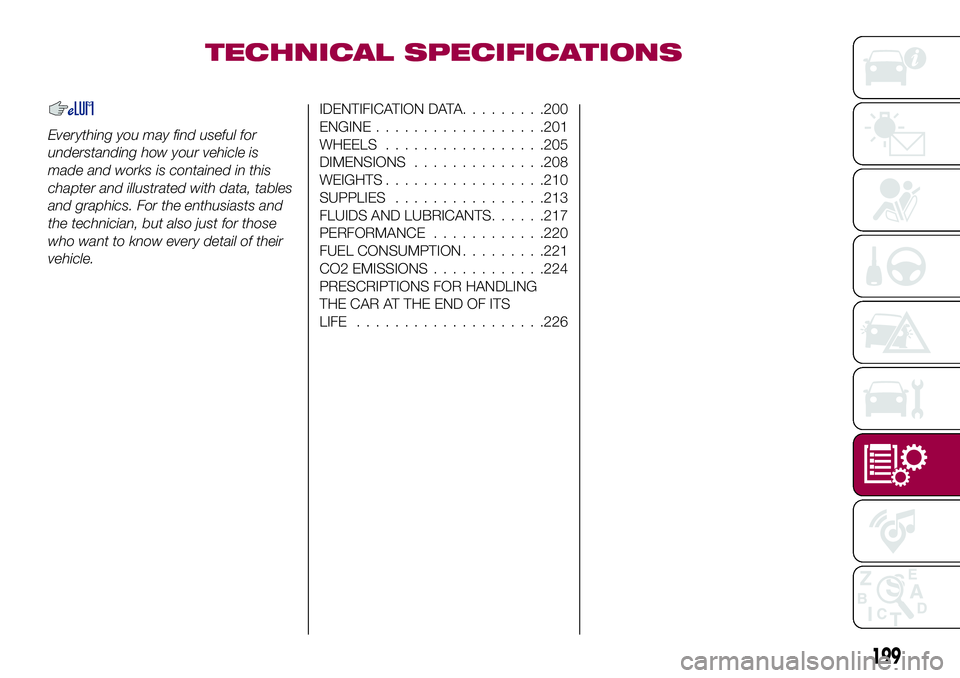
TECHNICAL SPECIFICATIONS
Everything you may find useful for
understanding how your vehicle is
made and works is contained in this
chapter and illustrated with data, tables
and graphics. For the enthusiasts and
the technician, but also just for those
who want to know every detail of their
vehicle.
IDENTIFICATION DATA.........200
ENGINE..................201
WHEELS.................205
DIMENSIONS..............208
WEIGHTS.................210
SUPPLIES................213
FLUIDS AND LUBRICANTS......217
PERFORMANCE............220
FUEL CONSUMPTION.........221
CO2 EMISSIONS............224
PRESCRIPTIONS FOR HANDLING
THE CAR AT THE END OF ITS
LIFE....................226
199
Page 210 of 284
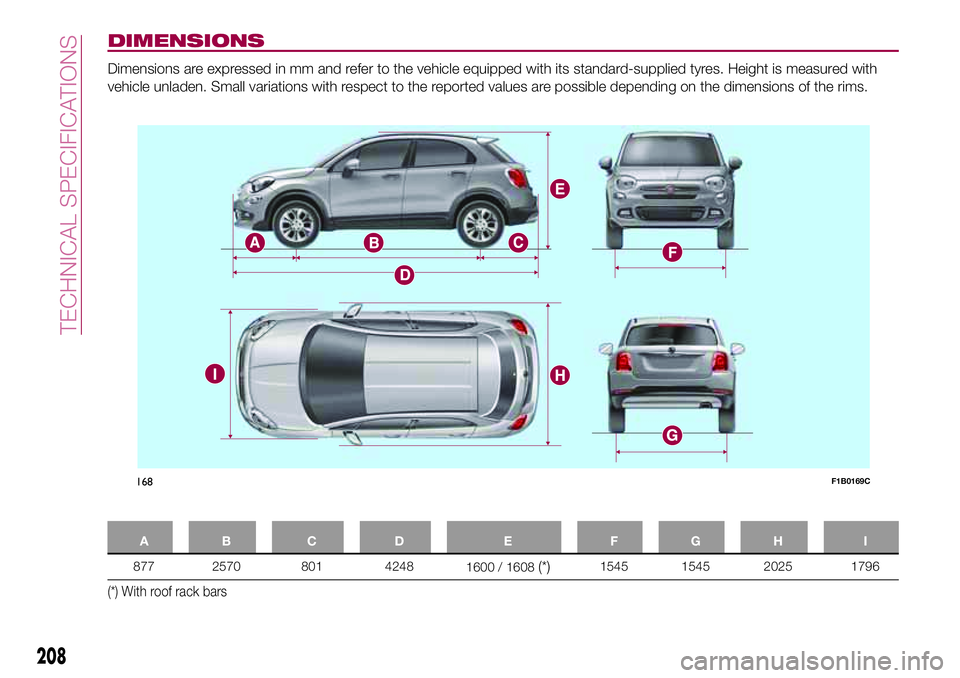
DIMENSIONS
Dimensions are expressed in mm and refer to the vehicle equipped with its standard-supplied tyres. Height is measured with
vehicle unladen. Small variations with respect to the reported values are possible depending on the dimensions of the rims.
AB C D E FGH I
877 2570 801 4248
1600 / 1608(*)1545 1545 2025 1796
(*) With roof rack bars
168F1B0169C
208
TECHNICAL SPECIFICATIONS
Page 211 of 284
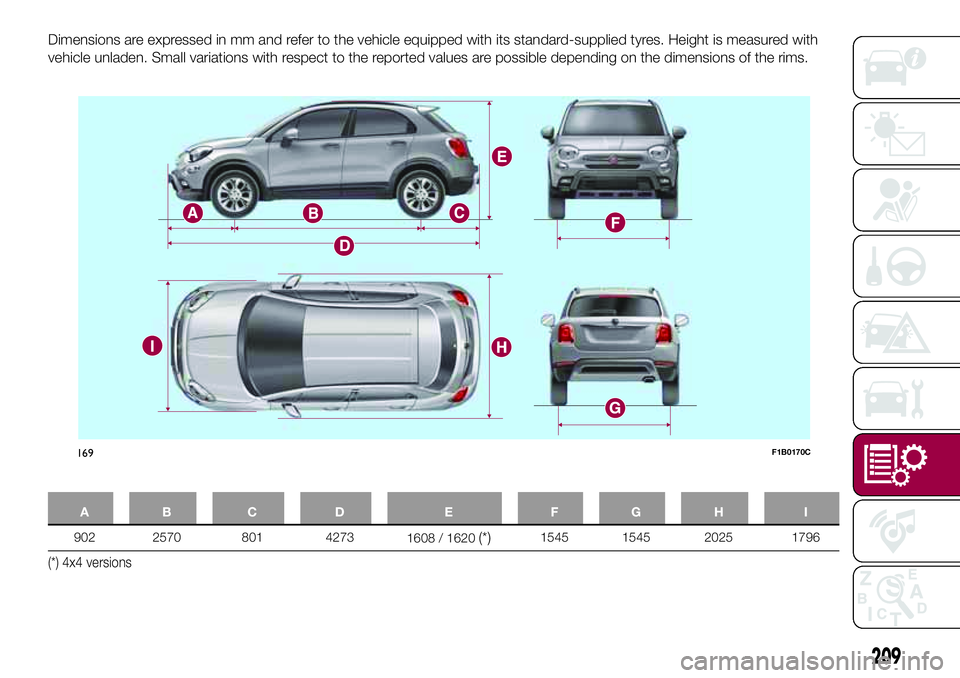
Dimensions are expressed in mm and refer to the vehicle equipped with its standard-supplied tyres. Height is measured with
vehicle unladen. Small variations with respect to the reported values are possible depending on the dimensions of the rims.
AB C D E FGH I
902 2570 801 4273
1608 / 1620(*)1545 1545 2025 1796
(*) 4x4 versions
169F1B0170C
209
Page 279 of 284
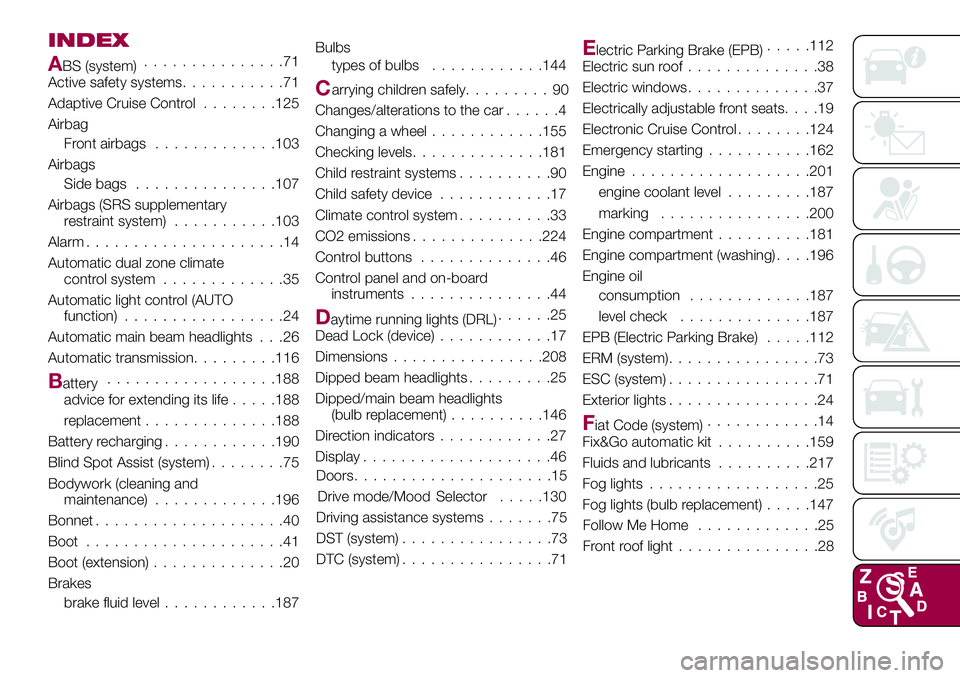
INDEX
ABS (system)...............71
Active safety systems...........71
Adaptive Cruise Control........125
Airbag
Front airbags.............103
Airbags
Side bags...............107
Airbags (SRS supplementary
restraint system)...........103
Alarm.....................14
Automatic dual zone climate
control system.............35
Automatic light control (AUTO
function).................24
Automatic main beam headlights . . .26
Automatic transmission.........116
Battery..................188
advice for extending its life.....188
replacement..............188
Battery recharging............190
Blind Spot Assist (system)........75
Bodywork (cleaning and
maintenance).............196
Bonnet....................40
Boot.....................41
Boot (extension)..............20
Brakes
brake fluid level............187Bulbs
types of bulbs............144
Carrying children safely.........90
Changes/alterations to the car......4
Changing a wheel............155
Checking levels..............181
Child restraint systems..........90
Child safety device............17
Climate control system..........33
CO2 emissions..............224
Control buttons..............46
Control panel and on-board
instruments...............44
Daytime running lights (DRL)......25
Dead Lock (device)............17
Dimensions................208
Dipped beam headlights.........25
Dipped/main beam headlights
(bulb replacement)..........146
Direction indicators............27
Display....................46
Doors.....................15
Drive mode/Mood Selector.....130
Driving assistance systems.......75
DST (system)................73
DTC (system)................71
Electric Parking Brake (EPB).....112
Electric sun roof..............38
Electric windows..............37
Electrically adjustable front seats....19
Electronic Cruise Control........124
Emergency starting...........162
Engine...................201
engine coolant level.........187
marking................200
Engine compartment..........181
Engine compartment (washing). . . .196
Engine oil
consumption.............187
level check..............187
EPB (Electric Parking Brake).....112
ERM (system)................73
ESC (system)................71
Exterior lights................24
Fiat Code (system)............14
Fix&Go automatic kit..........159
Fluids and lubricants..........217
Fog lights..................25
Fog lights (bulb replacement).....147
Follow Me Home.............25
Front roof light...............28
Page 280 of 284
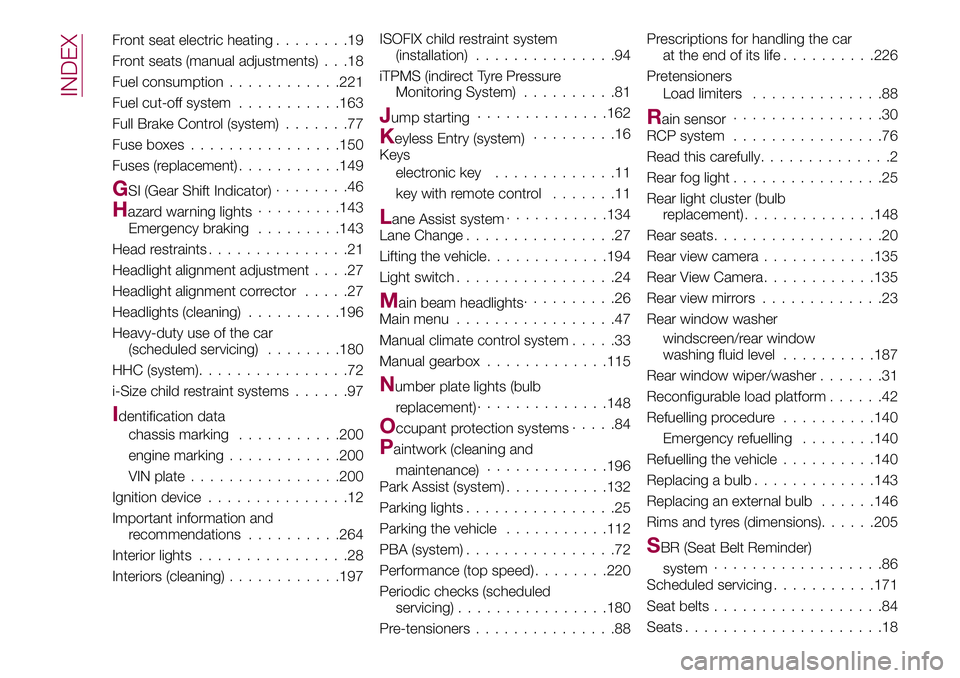
Front seat electric heating........19
Front seats (manual adjustments) . . .18
Fuel consumption............221
Fuel cut-off system...........163
Full Brake Control (system).......77
Fuse boxes................150
Fuses (replacement)...........149
GSI (Gear Shift Indicator)........46
Hazard warning lights.........143
Emergency braking.........143
Head restraints...............21
Headlight alignment adjustment....27
Headlight alignment corrector.....27
Headlights (cleaning)..........196
Heavy-duty use of the car
(scheduled servicing)........180
HHC (system)................72
i-Size child restraint systems......97
Identification data
chassis marking...........200
engine marking............200
VIN plate................200
Ignition device...............12
Important information and
recommendations..........264
Interior lights................28
Interiors (cleaning)............197ISOFIX child restraint system
(installation)...............94
iTPMS (indirect Tyre Pressure
Monitoring System)..........81
Jump starting..............162
Keyless Entry (system).........16
Keys
electronic key.............11
key with remote control.......11
Lane Assist system...........134
Lane Change................27
Lifting the vehicle.............194
Light switch.................24
Main beam headlights..........26
Main menu.................47
Manual climate control system.....33
Manual gearbox.............115
Number plate lights (bulb
replacement)..............148
Occupant protection systems.....84
Paintwork (cleaning and
maintenance).............196
Park Assist (system)...........132
Parking lights................25
Parking the vehicle...........112
PBA (system)................72
Performance (top speed)........220
Periodic checks (scheduled
servicing)................180
Pre-tensioners...............88Prescriptions for handling the car
at the end of its life..........226
Pretensioners
Load limiters..............88
Rain sensor................30
RCP system................76
Read this carefully..............2
Rear fog light................25
Rear light cluster (bulb
replacement)..............148
Rear seats..................20
Rear view camera............135
Rear View Camera............135
Rear view mirrors.............23
Rear window washer
windscreen/rear window
washing fluid level..........187
Rear window wiper/washer.......31
Reconfigurable load platform......42
Refuelling procedure..........140
Emergency refuelling........140
Refuelling the vehicle..........140
Replacing a bulb.............143
Replacing an external bulb......146
Rims and tyres (dimensions)......205
SBR (Seat Belt Reminder)
system..................86
Scheduled servicing...........171
Seat belts..................84
Seats.....................18
INDEX